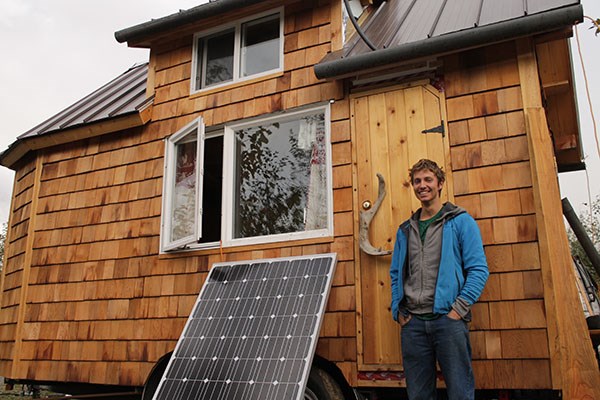Thinking big and building small – realizing large ideas by building little homes – is becoming a popular alternative to conventional housing in North America. Squamish is no exception.
Quest students Martin Schuster and Aaron Feicht are on the difficult, leading edge of this alternative approach to accommodation. For two years they’ve managed to stay warm through chilly winter nights and persuade the necessary authorities to let them continue residing in their designs.
The fourth-year students lease space from the university for $125 per month. They’ve found that compared to living in a conventional house, they save on utilities, rent and the cost of materials.
So far, the projects have cost Schuster $14,000 and Feicht $10,000, and given them both the distinct experience of building and living in their own homes.
Schuster was first to embark on this challenge by constructing his house on a trailer bed he towed to the Quest campus. Much of the wood he collected as scraps from the log sort and turned into the post-and-beam structure. Feicht joined Schuster a couple months later with his small house using a more conventional, stud-wall design.
Both houses are cozy, compelling efficiencies of design in terms of layout and use of space. Their windows are strategically placed to get the most from winter sun and their beds are high up to maximize heat through the night.
The District of Squamish doesn’t have a clear category for these types of structures and this was where the pair ran into bureaucratic difficulties. Schuster and Feicht ended up dealing with the district’s building inspectors, engineers and administrators, trying to have their houses legitimized.
“Most existing zones, including single-unit residential, small lot residential and rural residential have restrictions such as minimum building width or minimum dwelling unit size. Rezoning a parcel to a Comprehensive Development Zone would be one mechanism to develop a property to allow for unique house sizes and configurations,” district city planners said. The district considers non-standard rezonings like these on a case by case basis.
“It’s pretty confusing the bylaws that they have and whatnot,” said Schuster.
“What was really interesting was that we had presented them with this problem that had never really been addressed before and it looks like they were trying to figure it out for the potential of more in the future,” said Feicht.
Another small house in Squamish is the Snug House in Valleycliffe. The 1,309 square foot abode is substantially bigger than the houses of Feicht and Shuster, but still small by most standards. It is energy efficient by having thicker walls (eight inches), and passive heating through south-facing windows and thermal mass to retain heat within.
“Small is simple, and small is good,” architect James Tuer said of the project. “When you live in a big house you tend to fill it up with stuff and it is empowering to downsize and live with less. You spend more time outside the house.”



